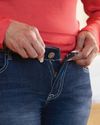
The causes
Healthy veins take blood from our feet and legs – where it has taken vital oxygen and nutrients – to the heart. But because it’s working against gravity, the blood will try to flow the wrong way.
This is prevented by one-way valves that open and close to let blood through. ‘Varicose veins occur when the small valves in our leg veins fail,’ says Professor Mark Whiteley, a consultant venous surgeon. ‘This allows blood to fall back to the ankles and feet, and collect in veins.’ Veins can become varicose if their wall is stretched and the valve is weakened. They become more common with age, and women are at risk because their hormones relax walls, making valves more prone to leaking. The biggest influence is genetics, says Professor Whiteley. ‘The more relatives you have with it, the more likely you are to have them.’
IT’S A MYTH
Crossing your legs won’t cause varicose veins. But anything that puts pressure on your legs or abdomen might, such as pregnancy, obesity or regularly standing for long periods.
Getting treated
Left untreated, they can lead to further health problems, such as aching legs, swollen ankles, blood clots, skin damage and venous leg ulcers – painful sores around the ankle.
Esta historia es de la edición March 24, 2020 de WOMAN'S WEEKLY.
Comience su prueba gratuita de Magzter GOLD de 7 días para acceder a miles de historias premium seleccionadas y a más de 9,000 revistas y periódicos.
Ya eres suscriptor ? Conectar
Esta historia es de la edición March 24, 2020 de WOMAN'S WEEKLY.
Comience su prueba gratuita de Magzter GOLD de 7 días para acceder a miles de historias premium seleccionadas y a más de 9,000 revistas y periódicos.
Ya eres suscriptor? Conectar

10 OF THE BEST Buys for CHARITY
Look great and support Breast Cancer Awareness Month this October

How to HAGGLE
Save those £££s by plucking up the courage to negotiate

Your wellbeing
LATEST HEALTH SOLUTIONS FOR YOUR MIND AND BODY

Here to help
LET COUNSELLOR KEREN LIGHTEN YOUR LOAD

Good to GLOW
Plant your bulbs now for a lovely bright start to spring

Painted VASES
Prettify empty jars and bottles with this quick craft project

Escape to OXFORD
Delve into the city's rich cultural heritage for a wonderful weekend

Sail through menopause WITHOUT WEIGHT GAIN!
Middle-aged spread may seem inevitable - but it really doesn't have to be

Woodland wonders
When you go down to the woods, you'll find a whole new world teeming with life

'We should all be dancing'
Singer and actor Toyah Willcox on overcoming adversity, ageing and Strictly Come Dancing